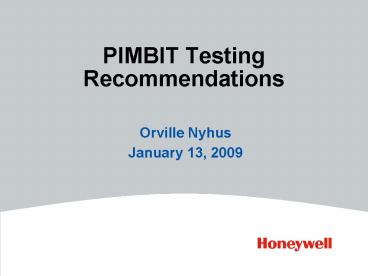PIMBIT Testing Recommendations - PowerPoint PPT Presentation
1 / 11
Title:
PIMBIT Testing Recommendations
Description:
High-Speed channel IM interfering with an active receive channel ... 'white' added noise of a high-speed IM product over the narrow channel bandwidth ... – PowerPoint PPT presentation
Number of Views:277
Avg rating:3.0/5.0
Title: PIMBIT Testing Recommendations
1
PIMBIT Testing Recommendations
- Orville Nyhus
- January 13, 2009
2
Fundamentals
- Primary objective is to determine possible
channel degradation due to PIM interference - This is not a directly measurable parameter
- A ratio of (IMCWN)/N can be measured
- Channel degradation can be computed from
(IMCWN)/N - This test requires no knowledge of LNA gain or
system RF cable loss factors - Measurement bandwidth is a user selectable
parameter - Measurements can be made with a variety of
equipment, e.g., SDU receiver or spectrum
analyzer, at manufacturers discretion
3
CW Carrier PIMBIT Concept
- Two-Tone CW Carrier Transmission Test
- Point HGA away from satellite orbit
- Generally North in Northern Hemisphere
- Generally South in Southern Hemisphere
- Transmit frequencies for PIM test
- Two test transmit frequencies to be provided by
Inmarsat - Impacted victim receiver frequencies also
provided by Inmarsat - Measure and record noise level N on victim
channel while no transmissions are in progress - Transmit two CW carriers at recommended EIRP
- Measure and record IMCWN level on victim channel
- Form (IMCWN)/N ratio from recorded data
- Compute channel degradation from measured
(IMCWN)/N ratio data
4
Channel Degradation
- Most Likely Interference Scenario
- High-Speed channel IM interfering with an active
receive channel - High-Speed channels operate at higher power than
narrower slower-speed channels and hence the
higher-power channels generate much stronger IM - Narrower channels suffer from essentially white
added noise of a high-speed IM product over the
narrow channel bandwidth - Receive channel Eb/(N0?N0) is degraded by
increase in noise (?N0) due to IM power spectral
density increasing the total channel noise above
the normal channel AWGN (N0) - Degradation can be expressed in terms of ?T/T
ratio where ?T represents the added noise
temperature due to the IM product where ?N0 k?T
and k is Boltzmanns constant - The channel degradation due to increased noise
is 10 Log10(T?T)/T 10 Log101 (?T/T) in
decibels - ?T/T can be calculated from a measured (IMCWN)/N
ratio
5
Knowledge of IM Bandwidth is Required
- IM Bandwidth is needed to Relate to Measured CW
IM Level - Relative to an un-modulated CW carrier of the
same total power the power spectral density of a
modulated PSK signal is inversely proportional to
the PSK symbol rate - Signal bandwidth is proportional to symbol rate
- The two-sided effective RMS IM bandwidth of a
root-raised-cosine filtered PSK signal is
spread as - Rsym is symbol rate
- P is IM product order
- Alpha is root-raised-cosine excess bandwidth
factor - Then IMCW BIM?N0 kBIM?T where k is
Boltzmanns constant
6
Knowledge of Detection Bandwidth
- Knowledge of the Detection Bandwidth used to
Measure (IMCWN)/N is needed to Convert to ?T/T - Measured noise is N BdetN0 kBdetT
- Where
- k is Boltzmanns constant
- Bdet is the receiver detection bandwidth
- N0 is noise power spectral density
- T is fundamental system noise temperature
7
Computation of Channel Degradation
- Based on Measured (IMCWN)/N and IM Product
Bandwidth and Detection Bandwidth Used One can
Compute ?T/T and Channel Degradation - With and
we have - And, therefore,
- Note that these factors are numerical, not in
decibels - With ?T/T derived from known and measured
quantities the channel degradation due to
increased noise on-channel can be computed as
(refer to Slide 4)
8
Example for Ninth-Order PIM for SBB
- Symbol Rate 151,200 sps
- Alpha 0.25
- BIM 257,135 Hz (P 9)
- Bdet 1 kHz (for this example)
- Recommended PIMBIT Failure Threshold
9
Typical PIM Measurement Example (SA)
- See Next Slide - Spectrum Analyzer (SA) Display
- fTX1 1627.0 MHz
- fTX2 1650.0 MHz
- EIRP (each CW channel) 20 dBW
- 9th Order IM Frequency 1535.0 MHz
- (IMCW N)/N ?MKR 25.84 dB
- Bdet 1 kHz (Resolution Bandwidth)
- Calculations for SBB
- Symbol Rate 151,200 sps
- Alpha 0.25
- BIM 257,135 Hz
10
Spectrum Analyzer Display - 9th Order PIM
11
www.honeywell.com































